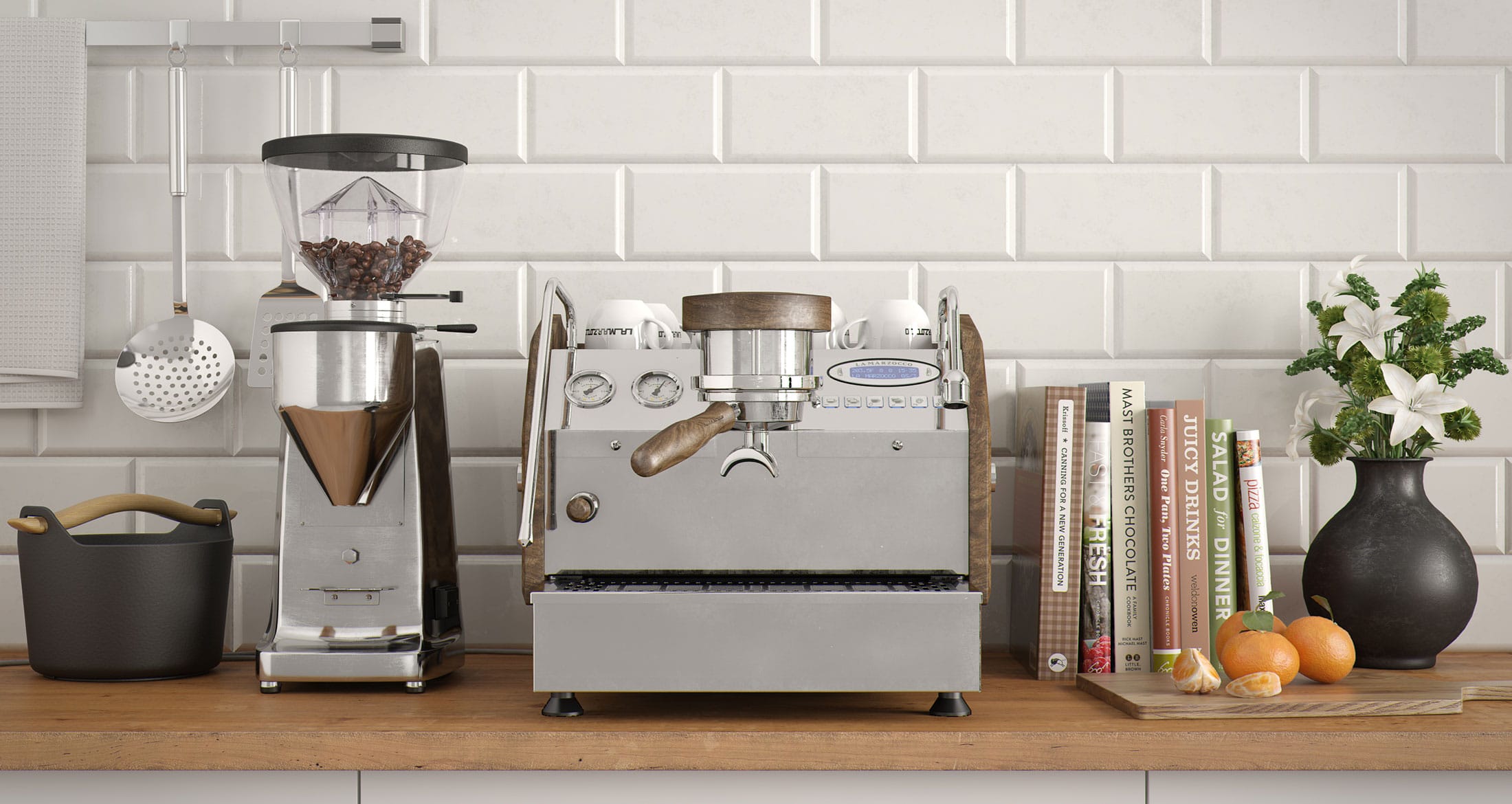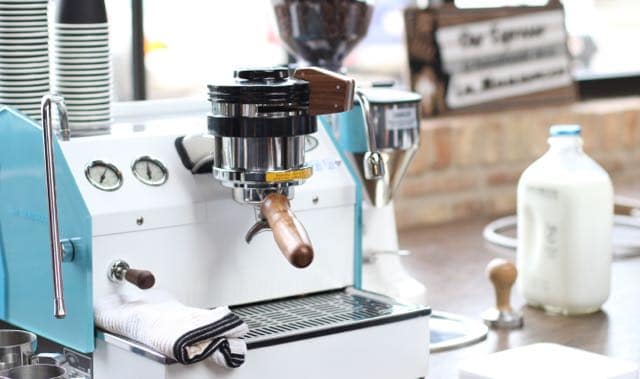| July 30th, 2015
Since 2007, the GS3 has been the standard in professional-grade home espresso machines. La Marzocco produsces two versions of the GS3—the AV (auto-volumetric) and the MP (manual paddle), and one of the most common questions we get here at La Marzocco Home is “what’s the difference between the AV and MP?”
To put it simply, the AV version uses an electronics package that allows for precise & repeatable shots that can be programmed by water volume while the MP gives the user manual control over pre-infusion and brewing times with paddle valve control. If you think of it like a car metaphor, it’s a little bit like the difference between driving a classic manual shift hotrod in the MP, versus a cutting edge supercar with electronic sports shifters in the AV.
Before we unpack what that all means for a barista using the machine on a daily basis, let’s talk a little bit more about the GS3 as a platform. The GS3 was released in 2007 as a full-performance commercial espresso machine fitted into a smaller body that can sit in a home or office, run on 120V electricity, and use its own water reservoir. Pulling from the same technologies as La Marzocco’s commercial machines, the GS3 is designed to provide a full array of tools for even the most demanding barista—including rock-solid PID-controlled temperature, dual boilers, and access to the MP and AV architectures found in the Strada and Linea lines.
That all sounds good, but what does it actually mean? In short, the GS3 was made to be the ultimate home espresso machine, freeing up a barista to explore espresso in any and every way, without worrying about whether the machine could keep up or if it would hold them back. No compromise on quality, and complete focus on the coffee.
The GS3 AV
At its most basic, the GS3 AV is a programmable espresso machine. Think consistency. It uses an electronically controlled espresso system, utilizing the same electronics package as the La Marzocco GB5 AV to actuate the pump and the grouphead’s solenoid valve to create the appropriate pressure to extract coffee. This electronic control is what actually enables the volumetric functions of the GS3. Attached to the cold-water side of the boiler is a small, wheel (called a flowmeter) that spins when water passes through. The AV is able to count and measure the precise amount of water that passes through the grouphead, and can be programmed by a user to dispense that same amount of water each time.
After dialing in a coffee, this makes it possible to extract shots using the same volume of water every time, simply by pressing a button. As we talked about in our “Dialing In” post, shot volume (espresso yield) is a key variable when brewing espresso, and being able to program it is incredibly valuable and allows the barista to focus on other variables such as grind size.
As you can imagine, the implication of programming shots isn’t only useful to a barista at home, but can be incredibly valuable in high-volume situations. Auto-volumetrics on machines is something that we’ve seen become more and more of a focus in high-volume, busy specialty coffee shops across the world. The four programmable buttons on the GS3 AV are perfect for anything from brewing individual shots at home to serving in high-volume situations like catering events.
The AV also has a few more bits of functionality thanks to the electronics. First, the ability to program pre-infusion times into each button. Say you’d like to program pre-infusion into your shot, the AV allows you to tell the machine, for example, to pre-infuse for 4 seconds, rest for 5 seconds, then begin brewing. Whether plumbed-in or using the reservoir, pre-infusion is accomplished by quickly engaging the pump for 1-5 seconds (adjustable for each AV preset), then disengaging for 1-5 seconds, then engaging the pump for brewing, which is able to replicate a smooth pre-infusion pressure curve.
One final feature of the AV is an automated cleaning cycle. This allows a barista to simply place a blind portafilter basket with detergent in the machine and press a couple buttons—the electronics handle the entire backflush cycle from there.
The GS3 MP
The GS3 MP by contrast is a much more manual machine, designed to capture the romance of classic espresso production. The MP grouphead—now in its fourth version—utilizes a paddle to open and close water flow to the grouphead by way of a ball-valve, as opposed to the AV’s electronic solenoid. As the paddle is moved to the left, the ball valve opens, and more water is allowed to pass through.
The paddle has three positions:
- Off: the valve is closed and the pump is off
- Pre-infuse: the valve is open for water flow but the pump is off
- On: the paddle is all the way to the left, activating a microswitch and turning on the pump that sends water at 9 bars of pressure to the grouphead for brewing
In essence, the paddle places the responsibility for starting and stopping the pre-infusion and brewing stages of the espresso shot solely in the hands of the barista.
The technical differences between the MP and AV architecture become more apparent when the GS3 is plumbed-in rather than operating off of the water reservoir. If you recall during the pre-infusion phase, the paddle is only half-way to the left, and the pump has not yet been engaged—so water only flows using whatever pressure is available. When an MP is plumbed in, the pre-infusion position of the paddle allows water to flow through the valve using line pressure (3-4 bars), creating a smooth, gentle pre-infusion stage that can be run for as long as the barista wants before engaging the pump and brewing at 9 bars.
But when operating off of the water reservoir, the GS3 MP preinfusion is limited to a smaller amount of pre-infusion. Line pressure isn’t present when using the reservoir, therefore only a small amount of water comes out during the pre-infusion phase—presenting itself more as a trickle than a consistent flow.
The ins and outs of pre-infusion can get quite technical, but the takeaway is that when plumbed in, the GS3 MP is able to do line-level pre-infusion for arbitrary amounts of time by holding the paddle in the center position. It is also possible to set the paddle to the middle position at the end of the brewing cycle to more slowly ramp down the pressure as the shot finishes. These two capabilities combine to give the barista more control over pressure with the MP, including the ability to re-create a more lever espresso machine-style pressure curve.
Final Thoughts
As our knowledge about espresso continues to grow, and the ability to tinker with more variables becomes more common, the decision between the AV and an MP rests not in which machine produces a better shot of espresso, but rather in the preferences of the barista. If you find value in programming shot volumes and pre-infusion times, you may find yourself leaning toward an AV. If you like having complete control on-the fly, you may find yourself leaning toward an MP. To bring us back to our original metaphor, the precision-tuned electronics package on the GS3 AV is able to compensate for “driver errors” and give the same handling and performance during any driving condition, while the GS3 MP is designed for maximum flexibility, giving dedicated drivers the tools necessary to finesse the smoothest possible power curves as they rocket down the espresso roadway.

